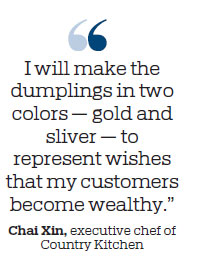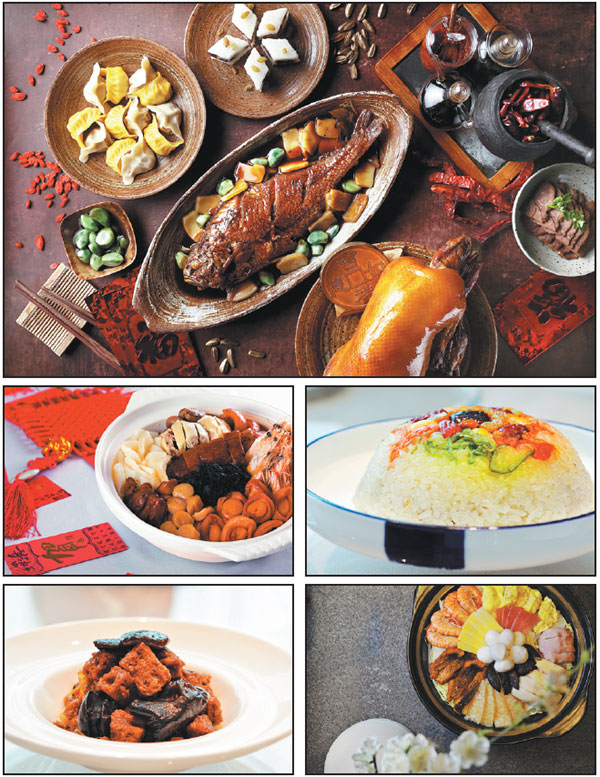Tabletop traditions
Different regions in China have their own delicacies for Spring Festival. Li Yingxue checks out restaurants in the capital that offer specialities from around the country.
Twenty-third, eat the sticky candy; 24th, clean the house; 25th, fry the tofu; 26th, stew the lamb; 27th, butcher the rooster; 28th, leaven the dough; 29th, steam the buns; and 30th, stay up all night.
So goes a Beijing folk song that describes how people prepare for Spring Festival, starting from the 23rd day of the 12th lunar month. Most of the activities revolve around food.
The Lunar New Year's Eve family-reunion dinner is the celebrations' main event. People from different areas have different traditions for that special meal.
Northerners eat dumplings. Shanghainese stew meats with egg dumplings. People in Guangdong and Hong Kong enjoy pencai, or poon choi, which literally translates as food served in small basins, as the main dish. All symbolize auspicious meanings.
Many Beijing restaurants are breaking out their best traditional recipes for holiday delicacies from around the country. China Daily looks at a few top spots for festival fare in Beijing.
Beijing cuisine
Country Kitchen's executive chef Chai Xin's Spring Festival dinner menu is inspired by his childhood memories of Beijing's hutong (traditional alleyways).
He still recalls wandering around and setting off firecrackers with his friends on Lunar New Year's Eve when he was a child.
"My grandma would stew a pot of meat and prepare equal numbers of cold and hot dishes for the dinner," Chai says.
He prepares braised mutton with soy sauce in old Beijing style for the feast. The mutton is boiled on a low fire for two to three hours and then is marinated in the soup for another five hours. It's next sliced and deep-fried to seal in the juices and aroma.
Pig-trotter jelly and black-chicken feet with pickled garlic are traditional cold dishes.
Chai recalls that his grandmother would put the stewed pig skin and soup in a bowl in the kitchen, which had no heating, and the pork-trotter jelly would be ready the next day.
His restaurant is adding chilled hawthorns to this year's menu to bring an authentic northern-style experience to the festival's meals.
Dumplings are a must for the big meal and are prepared before midnight to eat on the first day of Lunar New Year to bring good luck.
Chai prepares dumplings filled with baby cabbage, glass noodles, eggs and black fungus.
"I will make the dumplings in two colors - gold and sliver - to represent wishes that my customers become wealthy," he says.
Shanghainese cuisine
Chef Zhu Haifeng will not return to his hometown to celebrate Spring Festival with his family for the second consecutive year since he opened his Shanghainese-cuisine restaurant, Wulixiang, in the capital.
"We traditionally make egg dumplings in Shanghai," Zhu says.
"We hold raw egg in spoons and heat it while adding meat fillings. The most-fun part is folding it with your hand while holding it on the spoon."
The main dish is quanjiafu, which translates as whole family portrait. It's a stew of such ingredients as fish, chicken, pork and vegetables.
"The soup ... is really tasty because it has so many ingredients," Zhu says.
"We also put egg dumplings on top."
Traditionally, cold dishes are eaten before hot dishes during the Lunar New Year's Eve dinner. The stew is served last.
Zhu says the sixi (four-festive-ingredients) baked bran is the most common cold dish on every Shanghainese table.
"It's interesting that every family has its own sixi baked bran recipe and believes theirs is the most delicious," he says.
His version uses black fungus, mushrooms, day lilies and bamboo shoots.
"Eight-treasure" rice pudding is another indispensable Shanghainese dish.
Zhu has designed a family-dinner menu that adds a bit of modernity to the traditional annual feast.
Cantonese cuisine
Hong Kong chef Benson Fok has been working in kitchens for more than four decades. He previously worked for hotels and restaurants in such Asian countries as Indonesia, Singapore and the Philippines.
He was appointed as executive chef of Ming Court restaurant in Beijing at the end of last year.

And he's bringing one of Cantonese cuisine's most traditional dishes, poon choi, to Beijing's Spring Festival celebrations.
Poon choi is believed to date to the Song Dynasty (960-1279). It's said to originate in the walled villages of Hong Kong's New Territories.
The ingredients usually include pork, beef, lamb, chicken, duck, abalone, ginseng, fish maw, prawns, crabs, dried mushrooms, squid, dried eel, dried shrimp and pigskin.
"The ingredients of poon choi are becoming more plentiful every year," Fok says.
"When it started in the walled villages, people had limited access to fresh ingredients. But now we only use premium ingredients."
The dish traditionally took three days to prepare. The first day was spent collecting firewood in the mountains. The second was spent preparing fresh ingredients. On the third day, people would first cook the ingredients separately and then stew them together.
Fok takes more than a week to make his version, which uses at least 18 ingredients.
"Each ingredient has a separate cooking method and takes a different amount of time to prepare. For instance, dried abalone must be soaked for a week, and shrimp has to be pan-fried before it's stewed."
The ingredients are placed in the basin layer by layer. Those that can withstand intense boiling, such as radishes and lotus roots, are placed on the bottom. And the bamboo shoots and taro are added before the meat.
"The more valuable the ingredient is, the higher the layer it occupies," Fok says.
The dish also has to be tasted layer by layer, without mixing the ingredients, from the meat at the top down to the vegetables at the bottom.
"The best part of poon choi," Fok says, "is the atmosphere of the whole family gathered around the pot to eat it."
Contact the writer at liyingxue@chinadaily.com.cn
|
Clockwise from top: Beijing chef Chai Xin designs a northern-style Spring Festival family-reunion dinner for the coming Year of the Pig; "Eight-treasure" rice pudding; quanjiafu, a stew of various meats and vegetables; sixi (four-festive-ingredients) baked bran; poon choi, a traditional Cantonese dish for festival dinners. Photos provided to China Daily |
(China Daily 02/01/2019 page16)



















